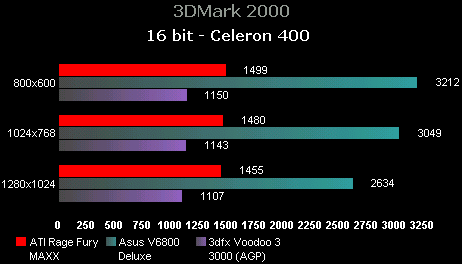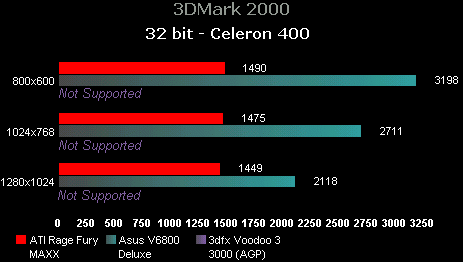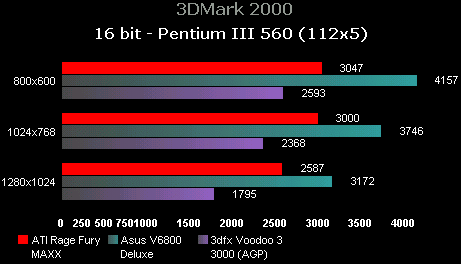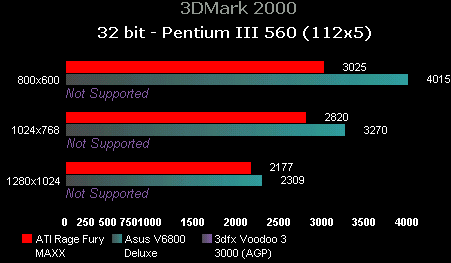
|
Less than top notch performance in the 3D gaming arena is what caused many gaming enthusiasts to shy away from ATi. Though ATi had the potential for becoming the 3D market leader, delays plagued the path of the Rage 128 chip on the way to market shelves. And in this industry, time is as valuable as money. So rather than being recognized as a leader in the graphics industry, OEM sales for low priced PC's and laptop's were their bread and butter.
70% Rating: 
|
|
|
|
Home >
Reviews >
Video Cards >
ATI Rage Fury MAXX |
|
|
Fillrate and Memory Bandwidth
By itself, the Rage
128 Pro chip is capable of pumping out data at a rate of 125MHz for a total fill
rate of 250 Mpixels/sec. Teamed with yet another similar chip, and you have a
product that is theoretically capable of outperforming Nvidia's Geforce256 GPU
which is rated at a lower 480 Mpixels/sec.
With
the SDRAM running at 143MHz and pushing data through a 128-bit pipeline, you
have a total memory bandwidth of nearly 2.3GB/sec.... for each processor! Thus,
our total available memory bandwidth available on the Rage Fury MAXX is a brute
4.6GB/sec! So what does all this mean? When using 3D applications at high
resolutions and colour depth, you then require a lot more memory per frame.
If your card can push that
data at a fast enough rate, you should not experience any significant slowdowns.
If your total memory bandwidth is low, it is your FPS rate which will begin to
suffer. Something especially noticeable at resolutions of 1280x1024 and
beyond...
Performance
Here we finally come down to the fundamental question. With all
the sheer theoretical power and the huge amount of texture space, how does the
Rage Fury MAXX stand up against competition of its time? We are going to compare
the MAXX with the Asus V6800 Deluxe as well as the 3dfx Voodoo3 3000 AGP. Here
is the summary of the test bed.
Test Bed Hardware
- Pentium
III 500 Slot 1 O/C'ed to 560MHz (112x5)
- Celeron 400 with Soltek SL-02A++
Converter Card
- Soltek SL-67KV Mainboard
- 128MB PC-100 SDRAM
-
Viewsonic E653 Monitor
- ATi Rage Fury MAXX
- Asus V6800
Deluxe
- 3dfx Voodoo3 3000 AGP
For each graphics card
tested, the latest drivers were used. In case of the Rage Fury MAXX, the newest
"unsupported" drivers were downloaded from the ATi website. Under
Quake 3, all default settings in Normal and High Quality were used
with the exception of a change in resolution. For the Direct3D (Unreal
Tournament) aspect of testing, our own "bloodlust.dem" was used to
simulate an extremely taxing scenario on any video
card.
3DMark
2000
First up on the
tests comes in the most recent addition from Mad Onion. Though purely a
synthetic benchmark and does not represent real world performance to much
extent. But because of the wide array of tests that it does perform, 3DMark 2000
should give a good indication of the overall performance of the card when
compared to others.




By looking at the scores, it is quite evident that
the Rage Fury MAXX requires pretty strong hardware in order to keep it
performing well. The Celeron 400 CPUs will not do any justice here. However,
also keep in mind that 3DMark 2000 does provide support for hardware T&L,
something which is not exhibited in the Rage Fury MAXX but is present in the
Asus V6800 Deluxe. This is another reason you see such a wide gap at
400MHz.
|
